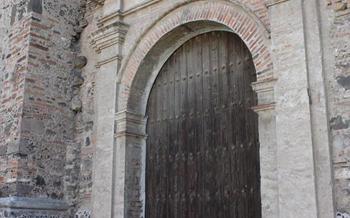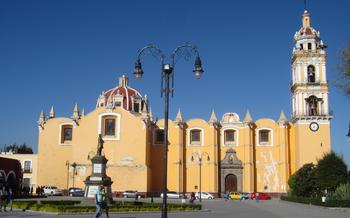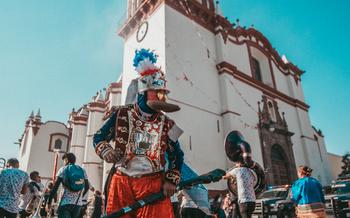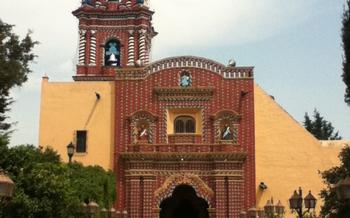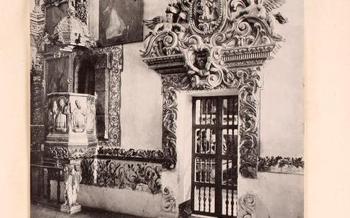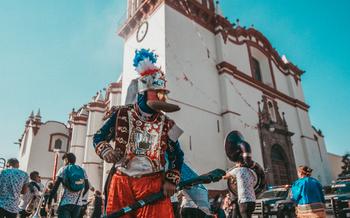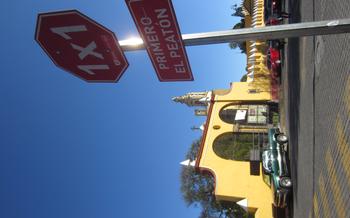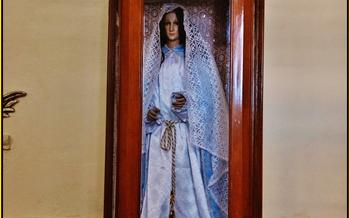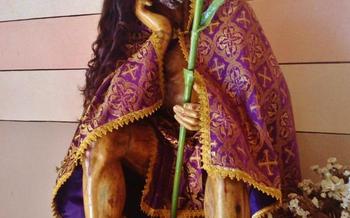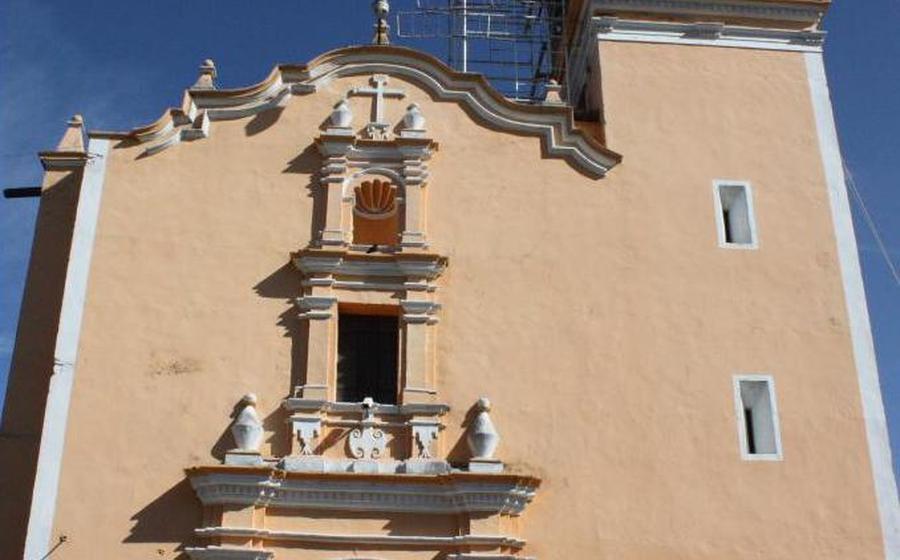
Templo de Santa María Cuaco
- History of the Templo de Santa María Cuaco
- Location and Accessibility
- Architectural Features
- Interior Highlights
- Religious Significance
- Historical Importance
- Cultural Heritage
- Guided Tours
- Photography and Videography
- Dress Code and Etiquette
- Accessibility for People with Disabilities
- Nearby Attractions
- Local Cuisine and Restaurants
- Insider Tip
- Insider Tip:
History of the Templo de Santa María Cuaco
The Templo de Santa back to the 16th century when Franciscan friars, driven by their missionary zeal, embarked on a quest to spread Christianity throughout the region. They recognized the strategic importance of Cholula, a city renowned for its indigenous heritage and religious significance, as a gateway to evangelizing the surrounding areas.
Under the leadership of Fray Martín de Valencia, the Franciscans laid the foundation stone for the temple in 154The construction, a testament to their unwavering faith, spanned several decades, with the imposing structure gradually taking shape. The fusion of Spanish Renaissance and indigenous architectural styles, a hallmark of the period, is evident in the intricate stone carvings, delicate arches, and vibrant murals adorning the temple's facade and interior.
The Templo de Santa María Cuaco, a symbol of the Catholic faith, became a beacon of hope and spirituality for the indigenous communities of Cholula. The friars, through their tireless efforts and devotion, transformed the city into a thriving center of Christianity, with the temple serving as its spiritual heart. The enduring legacy of their mission continues to resonate within the walls of this hallowed sanctuary, where the spirit of Catholicism remains vibrant and deeply cherished.
Location and Accessibility
The Templo de Santa María Cuaco is conveniently located in the heart of Cholula, a city steeped in history and cultural significance. To reach this architectural masterpiece, navigate to the following address: 4 Oriente 604, Centro Histórico, San Pedro Cholula, Puebla, Mexico. For those utilizing GPS coordinates, input these numbers: 1054207, -930618
Transportation options abound for travelers seeking to immerse themselves in Cholula's charm. From Mexico City, the journey by car takes approximately two hours. Alternatively, board a comfortable bus from the capital's TAPO bus station, ensuring a scenic and affordable ride. Once in Cholula, embrace the local culture by hailing a traditional "collectivo" or taxi to reach the temple's doorstep.
Parking near the temple is a breeze, with ample street parking available in the surrounding area. However, for those seeking a more secure option, several private parking lots are located within walking distance.
The Templo de Santa María Cuaco welcomes visitors of all abilities, ensuring that everyone can experience its architectural splendor. Wheelchair ramps and accessible entrances have been thoughtfully incorporated into the temple's design, allowing seamless navigation for those with limited mobility.
Architectural Features
The Templo de Santa María Cuaco stands as a testament to the harmonious blending of Spanish Renaissance and indigenous architectural styles. Its facade, adorned with intricate stone carvings and sculptures, captivates the eye with its ornate details. The intricate designs showcase the skill and artistry of the craftsmen who meticulously crafted each element.
Inside the temple, visitors are greeted by an awe-inspiring main altar, a masterpiece of elaborate ornamentation that draws the gaze upwards. The altar features a stunning altarpiece, adorned with intricate carvings and paintings that depict scenes from the Bible. The intricate wood carvings and paintings found throughout the interior add to the temple's visual splendor, telling stories of faith and devotion.
The impressive dome, a defining feature of the temple, adds to its grandeur. Its intricate design and vibrant colors create a sense of awe and wonder, symbolizing the heavens and the divine presence. The use of traditional materials and techniques in the construction of the temple, such as stone, adobe, and wood, adds to its authenticity and historical significance.
Interior Highlights
The Templo de Santa María Cuaco boasts an awe-inspiring interior that showcases a blend of Baroque and Renaissance influences. Upon entering, visitors are greeted by the main altar, an elaborate and ornate masterpiece that draws the eye with its intricate carvings, gilded accents, and vibrant colors. The altar is dedicated to the patron saint of the temple, Santa María Cuaco, and is adorned with her statue, which is believed to have miraculous powers.
The walls of the temple are adorned with beautifully preserved frescoes depicting biblical scenes and stories. These frescoes showcase the artistic talent of the indigenous painters who created them and provide a glimpse into the religious beliefs and practices of the time. The intricate wood carvings and paintings found throughout the interior further enhance the temple's visual appeal, adding depth and texture to the space.
Among the many notable features of the interior are the various chapels and side altars. Each chapel and altar is dedicated to a different saint or deity, and visitors can explore these spaces to learn more about the diverse religious traditions that have shaped Cholula's history. The Templo de Santa María Cuaco is a testament to the enduring power of faith and the artistic legacy of Mexico's indigenous peoples.
Religious Significance
At the heart of Cholula's religious landscape lies the Templo de Santa María Cuaco, a sacred space where faith intertwines with history. Serving as the spiritual cornerstone of the Catholic community, this temple is dedicated to the beloved patron saint, Santa María Cuaco. The people of Cholula hold her in deep reverence, believing in her miraculous interventions and seeking her protection and guidance.
Annual festivals and celebrations are held with great fervor to honor Santa María Cuaco, showcasing the profound devotion of the local community. These events erupt with music, dance, and colorful processions, drawing pilgrims and visitors from near and far. Within the temple's hallowed halls, the rhythmic chanting of prayers, the scent of incense, and the flickering of candles create an atmosphere of spiritual serenity and devotion.
Religious practices and rituals are meticulously observed within the temple, perpetuating centuries-old traditions. The faithful gather for Mass, seeking solace, comfort, and a connection with the divine. The temple's interior resonates with the melodies of hymns and the heartfelt prayers of the congregation, echoing through the centuries, carrying the weight of faith and devotion.
Historical Importance
The Templo de Santa María Cuaco stands as a testament to the rich and tumultuous history of Mexico. Its construction, which coincided with the arrival of the Spanish conquistadors, serves as a reminder of the profound impact of the conquest on the nation's religious landscape. During the colonial period, the temple offered refuge and shelter to both indigenous communities and Spanish settlers amidst the conflicts and upheavals that characterized that era. Over the centuries, the temple has undergone several renovations and restorations, each reflecting the changing political and cultural currents of the time. Its recognition as a national historical monument underscores its enduring significance as a symbol of Mexico's cultural heritage and resilience.
Cultural Heritage
The Templo de Santa María Cuaco stands as a testament European influences, reflecting the historical and cultural exchange that shaped the nation. The temple's architecture, art, and symbolism are a testament to the cultural continuity and resilience of the Mexican people.
The fusion of Spanish Renaissance and indigenous styles in the temple's design is a unique expression of Mexican identity. The intricate stone carvings and sculptures that adorn the facade and interior showcase the artistic prowess of indigenous craftsmen, while the overall structure and layout reflect the influence of European religious architecture. This harmonious blend creates a visual masterpiece that represents the cultural fusion that has come to define Mexico.
Beyond its architectural significance, the temple also holds cultural and historical value. It serves as a symbol of the ongoing dialogue between indigenous and European traditions, showcasing the ability of different cultures to coexist and influence one another. The temple's preservation and ongoing use as a place of worship further underscore its importance as a cultural heritage site.
The Templo de Santa María Cuaco is not just a religious edifice but also a symbol of cultural continuity and resilience. It has withstood the test of time, serving as a reminder of the strength and adaptability of Mexican culture. The temple's enduring presence and continued significance in the lives of the local community highlight its role in promoting cultural tourism and appreciation, allowing visitors from around the world to experience the vibrant cultural heritage of Mexico.
Guided Tours
Enrich your visit to the Templo de Santa María Cuaco by availing of guided tours conducted in various languages, including English and Spanish. These tours provide an immersive experience, allowing you to delve into the temple's history, significance, and captivating stories. Led by knowledgeable guides, these tours offer insights into the architectural details, religious practices, and cultural heritage associated with the temple.
Booking a guided tour is recommended to gain a deeper understanding and appreciation of this sacred site. Reputable tour operators offer various tour options, ensuring a seamless and informative experience. During the tour, you'll explore the temple's interior, marvel at the intricate frescoes, and learn about the symbolism behind the artwork.
Make the most of your guided tour by actively engaging with your guide, asking questions, and seeking clarification. Remember to arrive a few minutes before the tour's scheduled start time to avoid delays and ensure you don't miss any part of the experience.
Photography and Videography
Photography and videography are permitted within the Templo de Santa María Cuaco, allowing visitors to capture the temple's beauty and grandeur. However, it is essential to respect the sanctity of the religious space and adhere to the following guidelines:
-
Flash Photography: The use of flash photography is generally discouraged as it can be disruptive to worshippers and damage the delicate artwork within the temple.
-
Tripods: Tripods are not allowed inside the temple as they can obstruct the movement of visitors and disrupt the flow of foot traffic.
-
Respectful Behavior: Visitors are expected to be respectful of worshippers and maintain a quiet and contemplative atmosphere while taking photographs or videos.
-
No Commercial Use: Photography and videography are permitted for personal use only. Commercial use or the sale of images or videos without prior authorization is strictly prohibited.
-
Respecting Privacy: Visitors should avoid taking photographs or videos of worshippers or other individuals without their consent.
By following these guidelines, visitors can capture the beauty of the Templo de Santa María Cuaco while respecting its religious significance and the privacy of others.
Dress Code and Etiquette
When visiting the Templo de Santa María Cuaco, it is essential to dress respectfully, considering its religious significance. Visitors should opt for modest attire that covers their shoulders and knees. Avoid wearing shorts, tank tops, or revealing clothing. It is also important to be mindful of noise levels and maintain a reverent atmosphere within the temple. Photography and videography are permitted, but using flash or tripods may be restricted. Respect the privacy of worshippers and avoid taking photos or videos of them without their consent. Remember to switch off mobile phones or keep them on silent mode to minimize distractions. By observing proper etiquette and showing sensitivity to religious practices, visitors can contribute to preserving the sacred nature of the temple.
Accessibility for People with Disabilities
The Templo de Santa María Cuaco strives to be inclusive and welcoming to visitors of all abilities. While the temple's historic nature may present some challenges, efforts have been made to ensure that everyone can enjoy its beauty and significance.
For wheelchair users and visitors with limited mobility, the temple features ramps and accessible entrances. Designated parking spaces are also available nearby, making it convenient for those with disabilities to arrive and depart.
Although the temple's interior is adorned with intricate staircases, there are alternative routes and elevators to accommodate individuals who may have difficulty navigating steps.
It's important to note that some areas of the temple, such as the bell tower or the choir loft, may be inaccessible due to their architectural design. However, visitors can still appreciate the grandeur of these features from the ground level.
To ensure a comfortable and enjoyable experience for all, it's advisable to contact the temple administration in advance if you have any specific accessibility needs or concerns. They will be happy to provide assistance and ensure that your visit is as smooth and enjoyable as possible.
Nearby Attractions
A visit to the Templo de Santa María Cuaco can be effortlessly combined with other captivating attractions that Cholula has to offer. History buffs can delve deeper into the region's rich past at the nearby Museo Regional de Cholula, which showcases pre-Hispanic artifacts, colonial art, and intriguing exhibits on the history of Cholula. For those seeking a unique perspective, the Gran Pirámide de Cholula, the largest pyramid in the world by volume, is a must-visit. Its ancient tunnels and impressive architecture offer a glimpse into the ingenuity of ancient civilizations.
To soak in the vibrant local culture, a stroll through the bustling markets is a must. The Mercado Municipal de Cholula, just a short walk from the temple, offers an array of traditional Mexican handicrafts, colorful textiles, and fresh produce. For art enthusiasts, the Centro de Artesanía de Cholula showcases the works of local artisans, providing a platform for their creativity and preserving the city's artistic heritage.
To make the most of your Cholula exploration, consider planning a comprehensive itinerary that allows ample time to delve into the city's historical, cultural, and culinary offerings. With its captivating attractions and rich tapestry of experiences, Cholula promises an unforgettable journey into the heart of Mexico's cultural heritage.
Local Cuisine and Restaurants
Exploring the culinary delights of Cholula is an essential part of any visit to the city. In the vicinity of the Templo de Santa María Cuaco, visitors can find an array of inviting eateries showcasing the vibrant flavors of traditional Mexican cuisine. From cozy family-run restaurants to chic contemporary establishments, there is something to suit every palate.
For a taste of authentic Puebla-style cuisine, try the mouthwatering mole poblano, a rich and complex sauce served with chicken or pork. Another local delicacy is cemitas, delicious sandwiches filled with shredded meat, avocado, and a variety of toppings. For a refreshing treat, indulge in a glass of agua fresca, a refreshing fruit-based drink made with seasonal fruits.
Vegetarians and vegans can also find plenty of options in Cholula. Many restaurants offer creative plant-based dishes, such as tlacoyos, a traditional corn cake topped with beans, cheese, and vegetables, or enchiladas verdes, corn tortillas filled with cheese and smothered in a tangy green sauce.
To fully immerse yourself in the local culinary scene, consider taking a guided food tour. These tours offer a unique opportunity to sample a variety of dishes while learning about the history and traditions of Mexican cuisine.
Insider Tip
For a truly unforgettable experience, venture beyond the main tourist areas and seek out the hidden culinary gems of Cholula. Ask locals for recommendations on their favorite spots, or explore the city's vibrant markets, where you can find fresh produce, local specialties, and delicious street food.
Remember, the best way to savor the flavors of Cholula is to embrace the local culture and try new things. Enjoy the culinary delights that this vibrant city has to offer, and don't be afraid to ask for recommendations or step outside your comfort zone.
Insider Tip:
As you explore the Templo de Santa María Cuaco, take a moment to step outside and admire its exterior from a distance. From a slightly elevated vantage point, you'll notice that the temple's unique silhouette resembles that of a ship sailing through the horizon. This striking resemblance has earned the temple the affectionate nickname among locals: "The Ship of Cholula." Imagine the ancient mariners who navigated the vast oceans, guided by stars and celestial bodies. Let the Templo de Santa María Cuaco transport you back in time, as you marvel at its majestic presence, standing tall like a symbol of faith and resilience, amidst the ever-changing tides of history.
